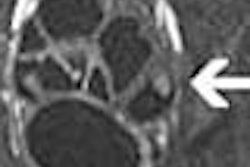Lippincott Williams & Wilkins, Philadelphia, 2002, $75.
Radiology residents are always trying to figure out the best, most efficient way to study for the written and oral boards. Hundreds of review books are available, but until recently, there hasn’t been an easily portable review resource. RadCards helps to fill this niche.
RadCards are composed of standard-size notecards for each of the ten sections covered on both exams. There are more than 500 cards in the deck, ranging in size and topics from chest imaging (70 cards) to gastrointestinal (45 cards) to pediatrics (50 cards). Topics covered in the remaining cards are musculoskeletal, ultrasound, neuroradiology, mammography, genitourinary, nuclear medicine, and interventional radiology.
Each card is set up with questions on the front and the answers on the back. The authors have included over 100 mnemonics (set off with a small drawing of a brain) with the answers. Likewise, imaging pearls are denoted by a small pearl symbol.
The overall layout and font of the cards is easy to read and pleasing to the eye. Questions on the cards emphasize differential diagnoses and contain helpful factoids within each section.
Overall, the differential diagnosis lists are complete. However, the differentials are not listed in order from more to less common entities -- a simple bit of organization that would be helpful to the reader as he or she prepares for the boards.
While most major topics are covered within each section of the cards, there were some curious omissions. For example, in the genitourinary section, a relatively high percentage of cards are dedicated to diseases of the cervix and prostate, but there is nothing on differential diagnosis of renal masses or stone disease.
A few other complaints: The loose cards are thin and relatively flimsy so they are easily deformed by rubber bands, and may wear down with use. Additionally, there are a number of typos and a few blank cards (no answer on back).
Still, this doesn’t detract wholly from RadCards usefulness. These cards would be most helpful to upper level residents who already have a solid foundation of knowledge as they offer a good study tool and memory refresher.
Having recently taken the written boards, I can attest to the fact that a lot of the information contained within the cards showed up on questions in this year’s examination. The portability of the cards will be especially appealing to those gung-ho residents who like to have a study resource with them at all times.
By Dr. Jeff KnakeAuntMinnie.com contributing writer
October 2, 2003
Dr. Knake is a fourth year radiology resident at the University of Virginia in Charlottesville. He will be a musculoskeletal radiology fellow at the university in July 2004.
If you are interested in reviewing books, let us know at [email protected].
The opinions expressed in this review are those of the author, and do not necessarily reflect the views of AuntMinnie.com.
Copyright © 2003 AuntMinnie.com



















